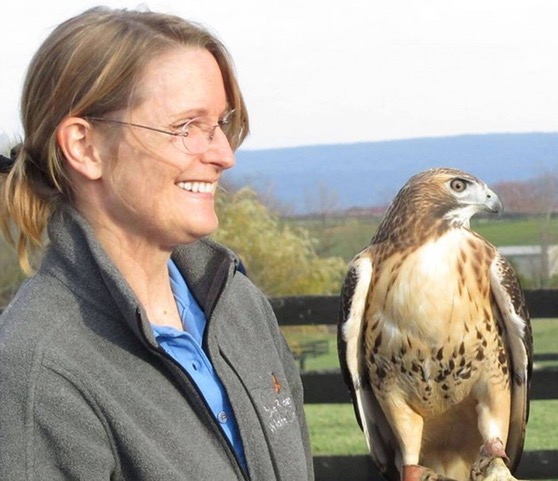Earlier this month, we reported on an Osprey rescued after it was found entangled in a tree near the Laurel Hill Golf Club in Lorton on July 19th. Follow-up on the bird’s story yielded additional information on how the incident unfolded and what has become of the young Osprey.
As reported (Springfield Connection, July 27-Aug 2, page 12) a call was placed to Animal Protection Police and with the help of Fire Station 441 and their ladder truck, they reached and rescued the bird. The alert eyes and reporting of Park Authority maintenance operations employees first spotted the bird. Maynard Slicker, working nearby, first saw the bird in distress, calling his supervisor, Beth Borostovik, who made the report. 
Slicker shared that the bird was entangled in the branches of its nest platform when he heard its distress calls. The bird likely freed itself from one entanglement only to be caught again in a nearby tree, from which it was eventually rescued by Firefighter P. Cortes and his fellow 441 crew members. The bird was transported by Animal Protection Police to a local veterinary care center, then moved to the Wildlife Rescue League. The League enlisted a specialist in the care of raptors, Dr Belinda Burwell of Boyce Va., to treat the Osprey.
Burwell was presented with a young bird, a fully fledged juvenile female, that is known to have hatched at the nest platform site off Lorton Road this May. Burwell found and treated minor abrasions to the Osprey’s left wing and foot. When placed in the flight cage that Wednesday, the bird was unable to fly, and initially was unable to use her left foot. Over the next five days, her strength increased to short flights and limping on her left foot, then to full recovery of her mobility. She was quickly released with another recovered Osprey into the Shenandoah River Valley that Sunday. Burwell commented that it is unwise to keep recovered birds longer than necessary since other problems may develop related to captivity.
“Fortunately this juvenile was a healthy weight and had fledged weeks before, so I’m sure she’ll be fine on her own with a good food supply available,” Burwell shared. “I wish we had received more information than only an address where found, but that is all I usually receive. It would be helpful in these cases to know the circumstances - for example if the bird was in the road and possibly hit, or in a yard near a window it could have struck, or how long it had been seen injured. Any little detail helps with these patients that can't talk to us.” While it would have been preferable to return the young Osprey to her family and home territory, Burwell indicated, “This juvenile very likely was hunting on its own and should be fine on the Shenandoah River.“ Osprey diets are mostly live fish which they dive into the water to catch.
Certified wildlife rehabilitator Nancy McDonald, known to many in Maryland as the 'Osprey Lady,’ says, returning a bird to the nest or home territory is always preferable, however, not always possible. “I rescue a lot of young ospreys that have fallen or been blown out of a nest that is inaccessible for multiple reasons.” She considers fostering rescued chicks or fledglings in another nest if a nest with the right number of similarly aged birds can be found. Osprey nests are numerous along Maryland’s Patuxent River and Jug Bay and their associated creeks and tributaries. She says, “Ospreys are challenging, since they need Mom and Dad to help them out right up to the moment they begin migration, and in a lot of cases, the parents leave before the babies.”
 Dr Belinda Burwell, certified rehabilitator, rescuing wildlife since 1987, with a hawk
Dr Belinda Burwell, certified rehabilitator, rescuing wildlife since 1987, with a hawk
The remaining Lorton Osprey family, two parents and a second juvenile, are expected to leave their nest platform in September or October to migrate south for the winter. According to the Virginia Institute of Marine Science, most Ospreys, who frequent the wider Chesapeake Bay region in the summer, spend the colder months in South America, ranging from Venezuela to as far south as Paraguay and Argentina. Adults typically return to their prior nesting sites in March, as the Lorton pair has done for multiple years. Young birds are thought to remain in the south until their second Spring season and don’t mate until their third year.
Looking beyond raptor rescue to the many species with which the Animal Protective Police officers must interact, Dr. Katherine Edwards, Fairfax County Wildlife Management Specialist, notes that “APP Officers respond to numerous calls for service for sick and injured wildlife, potential rabies exposures, orphaned or abandoned baby animals, wildlife within living spaces of homes or businesses, and animals that pose a threat to humans or pets. Public safety is paramount and is the first consideration for any response. Animal welfare is also taken incredibly seriously for both domestic animals and wildlife. … Officers make the best decision possible with the information and resources they have available at the time about whether an animal should be released, receive further evaluation by a rehabilitator or medical professional, or humanely euthanized to prevent suffering.”
As a result of the feedback provided by rehabilitators and veterinarians in the Lorton Osprey’s rescue, Edwards indicates the division is “taking measures to strengthen collaboration with local wildlife rehabilitators to incorporate their guidance into future practices.“
One young Osprey will never know the names, Slicker, Borostovik, Cortes, unnamed APPO, Burwell, McDonald, Edwards, or Ivancic. Yet readers do know and can be grateful for the many people who work hard to save the lives of wild things. All, as Edwards put it, “are thankful this young osprey has a second chance.”
